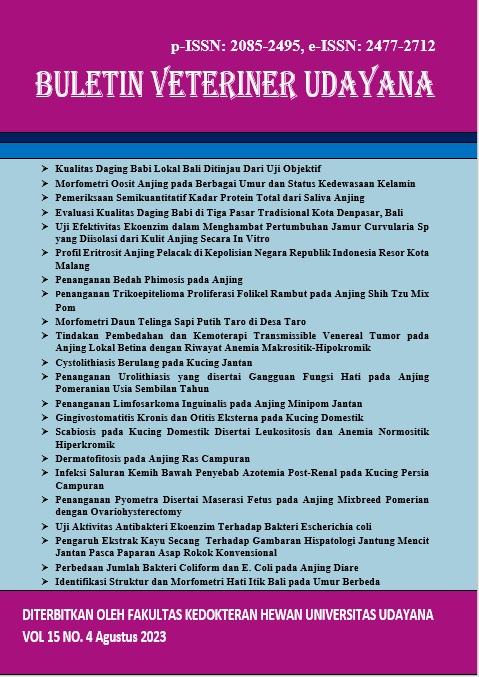EVALUATE EFFECTIVENESS OF ECO-ENZYME TO INHIBIT GROWTH OF CURVULARIA SP ISOLATED FROM DOG SKIN BY IN VITRO
Abstract
Dogs are very susceptible to infected by fungal species. The fungus that is often found infected dogs is Curvularia sp. Herbal medicine that is believed to be antifungal are ecoenzymes. The ecoenzymes in this study were made from papaya skin (Carica papaya L.), soursop (Annona muricata L.), neem leaves (Azadirachta indica A. Juss) and lemongrass (Cymbopogon nardus L.). This study was carried out to evaluate the effect of ecoenzymes against the growth of Curvularia sp used quantitative methode with modification of agar plate diffusion (Kirby Bauer) with well diffusion technique. This study was experimental and used a completely randomized design with 6 treatments, ecoenzyme concentration 5%, 10%, 15% and 100%, positive control used itraconazole, and negative control used aquades. Data analysis used ANOVA and continued with the Games-Howell test. The result showed that the inhibitory zones at ecoenzyme consentration 5%, 10%, 15%, and 100% were 3,50 mm; 4,82 mm; 6,02 mm; and 8,85 mm, respectively. Ecoenzyme in this study could inhibited fungal growth because of the ingredient contain antifungal substance like alkaloid carpaine, terpenoid, azadirachtin, nimbin, nimbidin, sitronela, and geraniol and pH reducer, so Curvularia spp that grew well in range of 4.0-10 could inhibited.
Downloads
References
Alture-Werber, E, Edberg SC. 1985. An animal model of Curvularia geniculata and its relationship with human disease. Mycopathologia. 89: 69-73.
Amelia S. 2011. Obat anti jamur (fungal). Departemen Mikrobiologi Fakultas Kedokteran: Universitas Sumatera utara.
Arifin LW, Syambarkah A, Purbasari HS, Ria R, Puspita VA. 2009. Introduction of Eco-enzyme to support organik Farming in Indonesia. Asian J. Food Agro-Industry. 2: 35-358.
Ben-Shlomo G, Plummer C, Barrie K, Brooks D. 2010. Curvularia keratomycosis in a dog. Vet. Ophthalmol. 13: 126-130.
Bent JP, Kuhn FA. 1996. Antifungal activity against allergic fungal sinusitis organisms. Laryngoscope. 106: 1331-1334.
Bridges CH. 1957. Maduromycotic mycetomas in animals; Curvularia geniculata as an etiologic agent. Am. J. Pathol. 33(3): 411–427.
Chen F, Feng X, Xu H, Zhang D, Ouyang P. 2012. Propionic acid production in a plant fibrous-bed bioreactor with immobilized Propionibacterium freudenreichii CCTCC M207015. J. Biotechnol. 164: 202-210.
Elad D, Orgad U, Yakobson B, Perl S, Golomb P, Trainin R, Tsur I, Shenkler S, Bor A. 1991. Eumycetoma caused by Curvularia lunata in a dog. Mycopathologia. 116: 113-118.
Giri DK, Sims WP, Sura R, Cooper JJ, Gavrilov BK, Mansell J. 2011. Cerebral and renal phaeohyphomycosis in a dog infected with Bipolaris species. Vet. Pathol. 48: 754-757.
Guarro J, Akiti T, Horta RA, Morizot Leite-Filho LA, Gené J, Ferreira-Gomes S, Aguilar S, Ortoneda M. 1999. Mycotic keratitis due to Curvularia senegalensis and in vitro antifungal susceptibilities of Curvularia spp. J. Clin. Microbiol. 37: 4170-4173.
Herraez P, Rees C, Dunstan R. 2001. Invasive phaeohyphomycosis caused by Curvularia species ina dog. Vet. Pathol. 38: 456-459.
Kaplan W, Chandler FW, Ajello L, Gauthier R, Higgins R, Cayouette P. 1975. Equinephaeohyphomycosis caused by Drechslera spicifera. Can. Vet. J. 16: 205-208.
Krizsán K, Papp T, Manikandan P, Shobana CS, Chandrasekaran M, Vágvölgyi C, Kredics L. 2015. Clinical importance of the genus Curvularia. Medical Mycology: Current Trends and Future Prospects; Razzaghi-Abyaneh, M., Shams-Ghahfarokhi, M., Rai, M., Eds, Pp. 147-204.
Kwochka KW, Calderwood MB, Ajello L, Padhye AA. 1984. Canine phaeohyphomycosis caused by Drechslera spicifera: A case report and literature review. J. Am. Anim. Hosp. Assoc. 20: 625–633.
Masri M, Latif M. 2015. Pengaruh ekstrak etanol daun serai wangi (Cymbopogon nardul L.) terhadap pertumbuhan fusarium oxysporum pada tanaman cabai (Capsicum annum L.). In: Seminar Nasional Biologi, Lingkungan, dan Pembelajaran.
Mathur RL, Kathur BL, Bhatnagar GL. 1960. Blackening of bajra grains in earheads caused by Curvularia lunata (Wakker) Boed. Syn. C. penniseti (Mitra) Boed. Proc. Nat. Acad. Sci., 30: 323-330.
Mavani HAK, Tew IM, Wong L, Yew HZ, Mahyuddin A, Ghazali RA, Pow EHN. 2020. Antimicrobial efficacy of fruit peels eco-enzyme against enterpcoccus faecalis: Int. J. Environ. Res. Pub. Health. 17(14): 5107.
Nazim F, Meera V. 2017. Comparison of treatment of greywater using garbage and citrus enzymes. Int. J. Innov. Res. Sci. Eng. Technol. 6(4): 49-54.
Pascutti K, Walton S. 2021. Internal medicine: approaches to opportunistic fungal infections in small animal. Today’s Vet. Practice. 2021: 84-94.
Patabang DL. 2021. Efektivitas madu trigona terhadap jamur curvularia sp yang diisolasi dari anjing. Skripsi. Fakultas Kedokteran Hewan: Universitas Udayana
Putri ACA, Suartha IN, Merdana IM, Sudimartini LM. 2018. Ekstrak daun mimba efektif terhadap microsporum gypseum yang diisolasi dari dermatitis pada anjing. Indon. Med. Vet. 7(6): 608-615.
Rao YH, Devi PS, Vemavarapu VV, Chowdary KR. 2020. Effect of pH & media on mycelial growth of curvularia spicifera causing curvularia leaf spot of tomato in Manipur. Int. J. Curr. Microbiol. App. Sci. 9(10):1721-5.
Robson AM, Craver RD. 1994. Curvularia urinary tract infection: a case report. Pediatr. Nephrol. 8: 83–84.
Sari AZ. 2014. Penyusunan penuntun praktikum berdasarkan hasil penelitian aktivitas antijamur daun pepaya terhadap capnodium mangiferae. Artikel Penelitian. Fakultas Keguruan dan Ilmu Pendidikan: Universitas Tanjungpura.
Serlin A, Suartha IN, Rompis ALT. 2020. Uji efektivitas ekstrak daun sirsak terhadap jamur microsporum gypseum penyebab dermatitis kompleks pada anjing. Bul. Vet. Udayana. 12(2): 155-160.
Singh RR, Solanki JS, Dalela GG. 1974. Note on the control of leaf spot of pearl millet, caused by Curvularia penniseti (Mitra) Boed. Indian. J. Agric. Sci. 43(9): 895-896.
Strzok E, Siepker C, Armwood A, Howerth E, Smith J, Banovic F. 2019. Successful treatment of cutaneous curvularia geniculata, nocardia niigatensis, and viral papillomatosis in a dog during the therapeutic management of immune-mediated hemolytic anemia. Front. Vet. Sci. 6: 249.
Sykes JE. 2013. Canine and feline infectious diseases. Elsevier Health Sciences.
Wilhelmus KR, Jones DB. 2001. Curvularia keratitis. Tr. Am. Ophth. Soc. 99: 111-132.
Win YC. 2011. Ecoenzyme activating the earth’s self-healing power. Alih Bahasa: Gan Chiu Har. Malaysia: Summit Print SDN. BHD. 6(8): 9-14.
Yau YCW, de Nanassy J, Summerbell RC, Mtlow AG, Richardson SE. 1994. Fungal sternal wound infection due to curvularia lunata in a neonate with congenital heart disease: case report and review. Clin. Infect. Dis. 19: 735-740.





